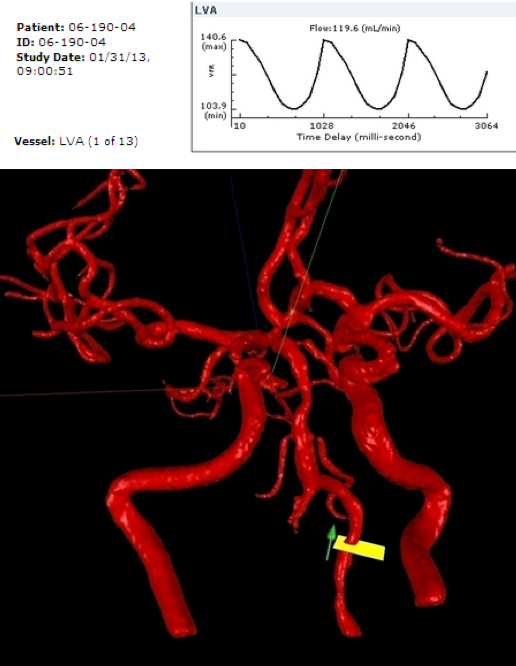Quantitative MRA with NOVA
A cerebral vessel blood flow study for patients at risk of stroke.
What is NOVA qMRA?
NOVA quantitative MRA employs a powerful principle in magnetic resonance imaging that allows doctors to measure the actual rate of blood flowing in arteries and veins. The NOVA imaging test is performed in combination with a standard magnetic resonance angiogram, MRA, that gives a visual roadmap of the blood vessels. NOVA adds a series of short scans of the cerebral vessels that each take less than a minute. Using the NOVA software, imaging specialists plan the precise location to measure blood flow on a rotatable 3D Model of the patient’s circulation. The approach is particularly useful in the brain, where the arteries are small and intricately winding through bone and soft tissue.
In a milestone study published in 2016 by the Journal of the American Medical Association Neurology, researchers reported that blood flow measurements from NOVA qMRA are a strong, independent predictor of stroke risk in vertebrobasilar disease, a condition which can cause one of the most dangerous types of ischemic stroke. The degree of narrowing in a blood vessel has long been thought to be predictive of stroke risk, but this new evidence shows that functional information, the amount of blood flowing to the brain, is in fact, what is most predictive. The study, called VERiTAS, demonstrated in vertebrobasilar disease the stroke risk is 5.5 times higher in patients who have low blood flow.
The symptoms include:
- dizziness
- loss of balance or sudden falls
- vision changes, double vision
- numbness or tingling in the face or the extremities
- garbled speech
- difficulty swallowing
- headache
- hearing loss
- nausea
Quantitative blood flow status determined by NOVA helps physicians develop an individualized treatment plan which considers a patient’s future risk of stroke.
What to expect during a NOVA qMRA exam?
A NOVA qMRA is like any other MRI exam. The patient will be screened to make sure they do not have metallic implants or another reason they cannot have an MRI.
NOVA is a completely non-invasive test and does not require intravenous injection of a contrast agent. The test will be performed in two parts, the Time of Flight MRA and the individual vessels scans. It is important for the patient to lie still for the duration of the exam to maintain the reference to the 3D roadmap.
Upon completion of the test, the doctor will have high resolution 3D images of the brain blood vessels and quantitative, physiological measurements of the brain blood flow. The NOVA study is much like the MRI flow mapping studies performed in the heart, where quantitative flow measurements have become a mainstay in diagnostics. Now NOVA brings that level of quantitative hemodynamics to the vessels of the brain.
NOVA qMRA is available at specialized neurovascular centers that treat stroke and other cerebrovascular disorders such as intracranial atherosclerosis, Moyamoya disease, cerebral venous thrombosis and arteriovenous malformations.
The NOVA Report
Schematic Vessel Map
Annotated map of the cerebral arteries with volumetric flow rate and direction of flow (green/yellow arrows).
Flow Summary
Flow Waveform and 3D snapshot for each vessel.
Where Can I go for a NOVA study?
For what conditions is a NOVA qMRA Exam Ordered?
- Vertebrobasilar Insufficiency
- Carotid occlusion
- Extracranial carotid stenosis, carotid artery disease
- Intracranial atherosclerotic disease
- Arterial Dissection
- Arteriovenous Malformation (AVM)
- Cerebral Venous thrombosis or stenosis
- Cerebral aneurysm
- Moyamoya Disease
- Stroke or TIA symptoms
Summary
NOVA qMRA provides a quantitative measure of blood flow in the major cerebral vessels for patients at risk of stroke from a range of cerebrovascular disease states. These include high risk conditions with multiple treatment decision points, encompassing medical therapy and complex interventions. NOVA qMRA supports clinical decision making and better outcomes, helping to ensure that patients receive the most appropriate treatment for their condition. This helps patients avoid unnecessary interventions along with the greater risk of complications and higher healthcare costs.



